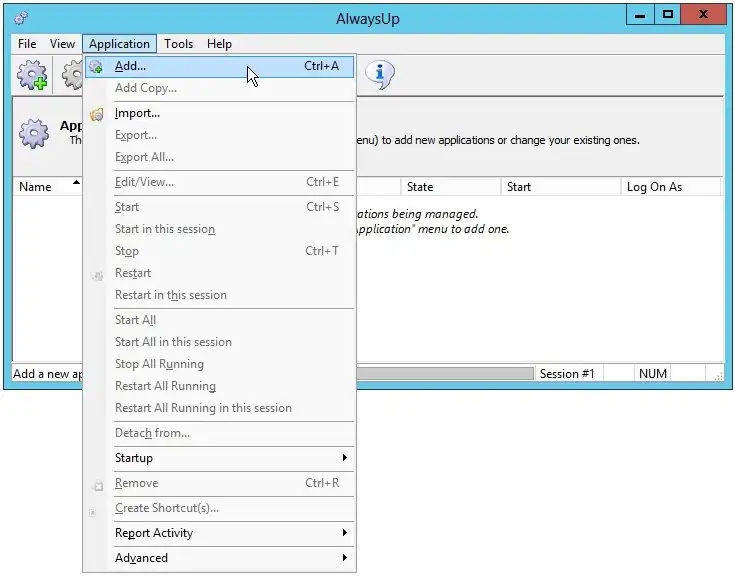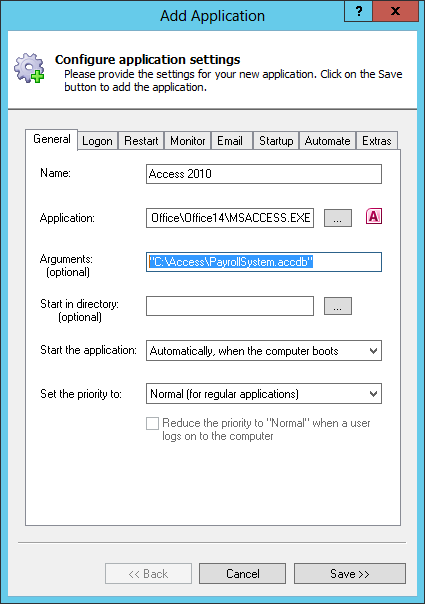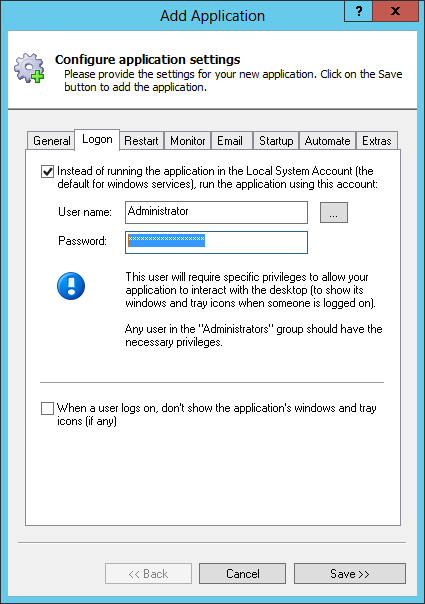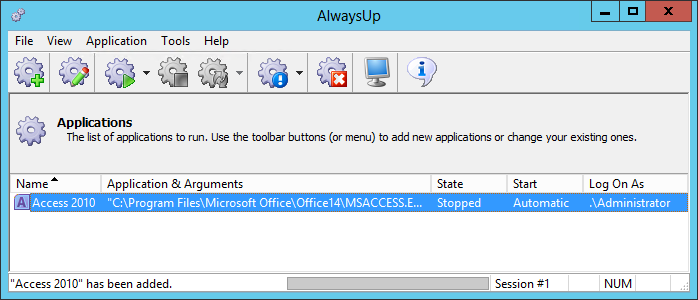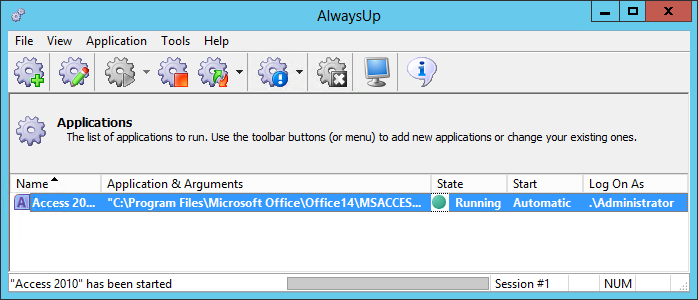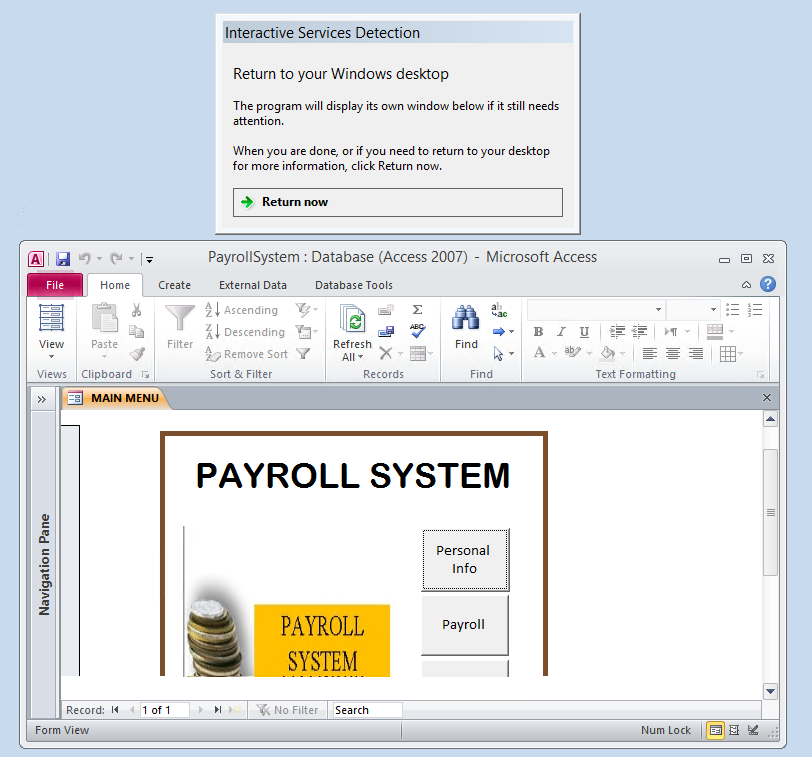
|
How to Run Microsoft Access 2010 as a Windows Service with AlwaysUp |
Start your MS Access database application (*.ACCDB/ACCDE/MDB) when your computer boots - no need to log on first
Access 2010 is Microsoft's popular, pseudo-relational database platform, included with higher-end editions of the Office 2010 productivity suite.
Note: Microsoft raises the red flag when running any program in its Office suite as a Windows Service.
However the most significant problems arise when running in the LocalSystem account and AlwaysUp can get around that. Nevertheless, please be
sure to thoroughly test your database and automation to ensure that Access 2010 works as expected.
To setup Access 2010 to run as a Windows Service with AlwaysUp:
-
Download and install AlwaysUp, if necessary.
-
Start AlwaysUp.
-
Select Application > Add to open the Add Application window:
-
On the General tab:
-
In the Application field, enter the full path to the Microsoft Access executable, MSACCESS.EXE.
If you installed Access in the default location, this is either:
C:\Program Files\Microsoft Office\Office14\MSACCESS.EXE
or
C:\Program Files (x86)\Microsoft Office\Office14\MSACCESS.EXE
on 64-bit systems with the 32-bit version of Access/Office installed.
-
In the Arguments field, enter the full path to your Access database file (*.ACCDB/ACCDE/MDB) - enclosed in double quotes (") if it contains a space. For this tutorial we'll use
this freely available Access payroll system,
which we have placed in C:\Access\PayrollSystem.accdb.
Note that Access 2010 supports several command line switches which can be specified in the Arguments field as well.
For example, you can pass a user name and password if your database is protected, or open the database for exclusive use.
Here are the options for Access 2007 - apparently things haven't changed since then.
-
In the Name field, enter the name that you will call the application in AlwaysUp.
We have used Access 2010 but you can specify something more meaningful if you like.
-
Click over to the Logon tab and enter the user name and password of the account in which you installed and configured Access (or Office).
Access 2010 must run in this account so that it can find its settings, and it will not work if you don't specify the correct account here!
-
Click the Save button. In a couple of seconds, an application called Access 2010 will show up in the AlwaysUp window.
It is not yet running though (the State column will show "Stopped").
-
To start your application, choose Application > Start "Access 2010". In a few seconds, the state should transition to Running.
On Windows 8/7/Vista and Server 2012/2008, you will not see the Access GUI because your application is running in the background in
the isolated Session 0.
Choose Application > Start "Access 2010" in this Session if you wish to start Access on your desktop, or
select Tools > Switch to Session 0 to visit the dreary looking Session 0 desktop (pictured here running the sample payroll database we configured in this tutorial):
-
That's it! Next time your computer boots, your Access 2010 database application will start up immediately, before anyone logs on.
We encourage you to edit the entry in AlwaysUp and check out the many other settings available.
For example, add a delay on the Startup tab if Access must wait for other applications to start at boot, get notified by email when Access crashes, and much more.
Access 2010 not working properly as a Windows Service?
-
Consult the AlwaysUp Troubleshooter - our online tool that can help you resolve the most common problems encountered when
running an application as a windows service.
-
From AlwaysUp, select Application > Report Activity > Today... to bring up a HTML report detailing the interaction between AlwaysUp and Access 2010.
The AlwaysUp Event Log Messages page explains the more obscure messages.
-
Running Access in the background unattended can be tricky, especially when it throws up a prompt that
interrupts the action. If these can not be eliminated from your code, you may want to investigate using an automation script/program
to automatically dismiss the pesky windows. Please see the
Automate tab
(or the AlwaysUp User's Manual)
for additional information on automation.
-
Review the AlwaysUp FAQ for answers to commonly asked questions and troubleshooting tips.
-
Contact us and we will be happy to help!
|
Over 97,000 installations, and counting!
|
 |

|
Rock-solid for the past 20+ years!
|
Fully Compatible with 160+ Applications...
|

